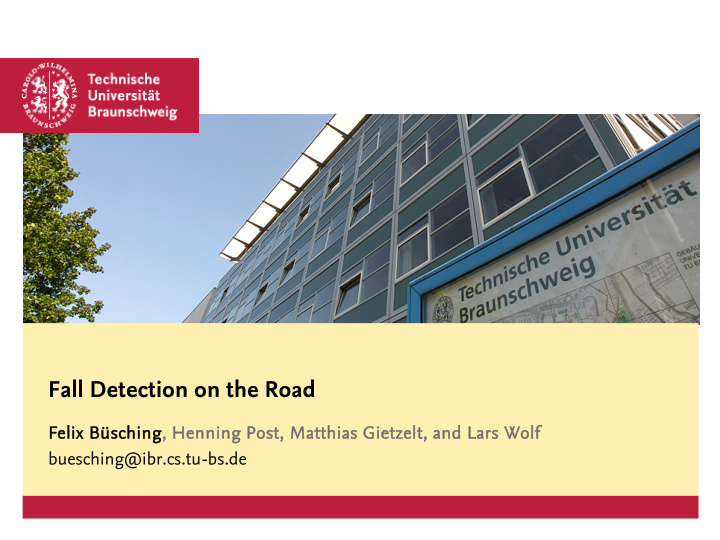



Platzhalter für Bild, Bild auf Titelfolie hinter das Logo einsetzen Fall Detection on the Road Felix ix B Büs üsching hing, , Henning nning P Post, Matthia hias Gietze zelt lt, , an and L Lar ars Wol olf buesching@ibr.cs.tu-bs.de
Personal Emergency Response System (PERS) Observed behavior 1: Normal usage Works – since several years Fall occurs Button pressed Alarm initiated Felix Büsching | Fall Detection on the Road | 2
Personal Emergency Response System (PERS) – Non-Usage Observed behavior 2: Non-usage Forgets to wear sender Doesn’t even know where it is Fall occurs No button to press No alarm Felix Büsching | Fall Detection on the Road | 3
Personal Emergency Response System (PERS) – Refused Usage Observed behavior 3: Refused usage “The mobile nursing service will come anyway – in 2-4 hours” “I’ll wait here on the floor – don’t want to bother anyone” Fall occurs Button not pressed No alarm Felix Büsching | Fall Detection on the Road | 4
Personal Emergency Response System (PERS) – Anxious Usage Observed behavior 4: Anxious usage “I feel safe – I better wear that thing 24/7” Many false alarms during nighttime Bad dream occurs False Alarm Button accidentally pressed Felix Büsching | Fall Detection on the Road | 5
Personal Emergency Response System (PERS) – Avoidance Behavior Observed behavior 5: Avoidance behavior “System works good at home.” ”So, why leave it and enter the unsafe outside?!” Felix Büsching | Fall Detection on the Road | 6
Summary: Personal Emergency Response System (PERS) 1. Normal usage OK, this is boring… 2. Non-usage Indoors: Fixed Sensors (Cameras, Laser Scanners, etc.) 3. Refused usage Additional autonomous fall detection and automatic alarm notification 4. Anxious usage Only autonomous fall detection and automatic alarm notification 5. Avoidance behavior System that also works “on the road” Mobile PERS with autonomous fall detection needed… here we go! Felix Büsching | Fall Detection on the Road | 7
Some Related Work PerFallID [1], iFall [2] Systems/Applications for Android Smartphones Detect falls with built in sensors Report falls via 2/3/4G connection Additional location information via GPS Everybody owns a smartphone! Enough processing capabilities for fall detection Communication interfaces for alarm messages Problem solved?! [1] J. Dai, X. Bai, Z. Yang, Z. Shen, and D. Xuan, “Mobile phone-based pervasive fall detection,” Personal and Ubiquitous Computing, vol. 14, no. 7, pp. 633–643, 2010. [2] F. Sposaro and G. Tyson, “ifall: An android application for fall monitoring and response,” in Engineering in Medicine and Biology Society,2009. EMBC 2009. Annual International Conference of the IEEE, 2009. Felix Büsching | Fall Detection on the Road | 8
Limitations of Smartphones Position on the body Pocket Jacket Handbag Battery Lifetime – HTC Dream PerFallID: 33.5 hours Idle time: 402 hours (according to HTC) less than 10% of nominal time in reality: depends on usage never enough! Felix Büsching | Fall Detection on the Road | 9
One Single Device for Indoor and Outdoor Usage?! Smartphone?! Charging when returning home Not able to detect falls @home PSTN better suited for alarm messages 2/3/4G networks are not that stable Smartphone cannot be the single PERS device! “Pimped” wearable sensor?! Adding 2/3/4G communication interfaces Lifetime decreased Cost added No single device possible Felix Büsching | Fall Detection on the Road | 10
Proposed System: 3 Parts One and the same senor for fall detection Two systems for emergency calls: Home station & Smartphone A B d >d >d Felix Büsching | Fall Detection on the Road | 11
System for Mobile Fall Detection Android Smartphone: e.g. Motorola Milestone ARM Cortex A8 550 MHz, 256 MB RAM, 512 MB ROM Accelerometer, Compass, Light-Sensor 3G, Bluetooth INGA Wireless Sensor Node 8-bit Microcontroller @ 8 MHz, 16 kB RAM, 128 kB Flash, SD Accelerometer, Gyroscope, Barometric Pressure Sensor IEEE 802.15.4 radio, additional Bluetooth radio Felix Büsching | Fall Detection on the Road | 12
On the Road… Emergency Messages Sent by Smartphone Via 2/3/4G network Where to Implement the Mobile Fall Detection? Obviously not in the Home Station Possible solutions 1. Sensor sampling and fall detection on smartphone 2. Sensor sampling on node, fall detection on smartphone 3. Sensor sampling and fall detection performed by node Felix Büsching | Fall Detection on the Road | 13
Evaluation: Energy Consumption of Smartphone 100 Idle 99 FD on INGA FD on Smartphone 98 Receive & Process Battery Level [%] 97 96 95 94 93 92 0 200 400 600 800 1000 1200 Time [min] Felix Büsching | Fall Detection on the Road | 14
Evaluation: Energy Consumption of Smartphone – R&P Detailed 100 90 Idle and Others 80 R&P: 16 Sample/s R&P: 32 Sample/s 70 Battery Level [%] R&P: 64 Sample/s 60 50 40 30 20 10 0 0 50 100 150 200 250 300 Time [min] Felix Büsching | Fall Detection on the Road | 15
Evaluation: Energy Consumption of INGA Node 4,20 4,15 4,10 4,05 Battery Level [V] 4,00 3,95 Idle 3,90 FD on INGA 3,85 S&S: 16 Sample/s 3,80 S&S: 32 Sample/s 3,75 S&S: 64 Sample/s 3,70 0 50 100 150 200 250 300 Time [min] Felix Büsching | Fall Detection on the Road | 16
Conclusion Mobile PERS with Fall Detection is needed to … Cope with “avoidance behavior” Handle “refused” and “anxious usage” Sensor Node for Data Sampling Determined position at body One and the same device Sensor Node for Fall Detection Algorithms Takes advantage of interrupt routines No continuous transmission -> low energy Thanks for the attention! buesching@ibr.cs.tu-bs.de Felix Büsching | Fall Detection on the Road | 17
Recommend
More recommend